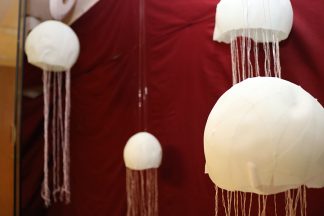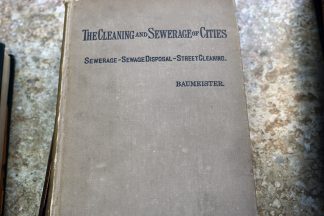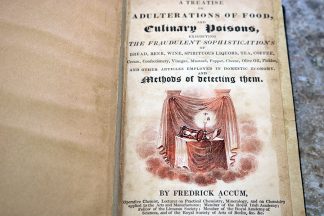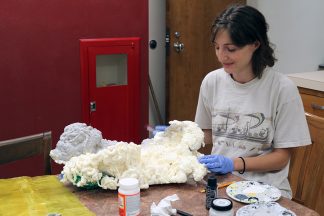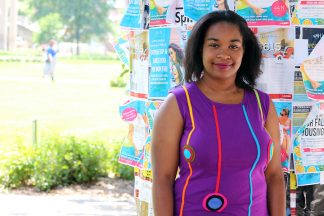by A’Davian Smith
Here at the Wangensteen Historical Library of Biology and Medicine there are collections of rare books, manuscripts, and much more! This September a new exhibit, Underwater, will open to the public for the first time — exploring the intersection of humans, health, and science in watery spaces.
From behind-the-scenes of the exhibit preparation, I sat down with curators Emily Beck and Lois Hendrickson as they walked through the process of showcasing their exhibit for the public.
Selecting a theme
As I am interviewing Beck and Hendrickson, I asked some questions in regards to how they selected their theme. They mentioned that there were many influences such as local interest in lakes along with water-related initiatives at the University of Minnesota.
“We knew that there are lots of groups on campus that do research in and around water,” Beck said.
Beck added that these existing interests and the cool things that they have in their collection made the underwater theme a good intersection of scholarship, curiosity, and history for their audience.
Researching the topic
When it comes to researching an exhibit theme, it’s all about lots of reading! Both Beck and Hendrickson took time out of their schedules to read books, articles, and publications that were more recent and current to their topic. They even checked out exhibit websites that explored similar themes.
It takes about two years to put together all the sources and content for the exhibit, since exhibit prep needs to fit in between teaching, researcher support, and other special events.
They often work with volunteers and students to create an exhibit. For this exhibit, U of M graduate Andrew Kuehne helped sift through books and chose exhibit materials.
Selecting content
When I think of underwater, I tend to think of Finding Nemo or mermaids. This exhibit takes a broader perspective of underwater — tying in aspects of health and wellness. The exhibit cases cover topics including scurvy, drowning, artificial respiration, pharmaceutical products from the ocean, and aquariums. And I was excited to see that even mermaids make an appearance.
When selecting relevant content from their collection, they take what they learn from their research and start building the exhibit. Beck said, “We start with several hundred books, but our cases only have room for about 25-30 books.”
Beck adds that they usually spend several months going through the books, categorizing them in different ways, and thinking about how they are all in conversation with each other.
By looking at all these books, they can find the themes they want to explore and they learn if they have enough content that meets their criteria for the exhibit. They consider illustration, language, diversity in points of view, and types of material — among other things.
They also take in consideration what should and shouldn’t be shown. For example, many images related to health and disease are difficult to look at and not suitable for all audiences.
In the process, the curators increase their knowledge and familiarity with resources in their collection so they can use their new expertise as they support scholarship and use of materials.
Designing the exhibit
Before setting up their exhibit, Beck and Hendrickson visited museums and other libraries to inspire their work.
Beck says, “We spend time visiting museums, like the Minneapolis Institute of Arts, to see how the look and feel of different exhibits will resonate with our audience.”
They also find inspiration in the world around them. Restaurants, store windows, art installations and Pinterest boards are just a few of the many examples.
As Hendrickson and Beck create the exhibit design, they work to make the books the real showpiece while placing them in an interesting space that adds context.
“Making the cases feel like a specific place, like a ship captain’s office or a seaside malt shop, is one way to make the cases interesting but still draw exhibit attendees to the books,” Beck explains.
Beck and Hendrickson work closely with Darren Terpstra, the Libraries exhibit designer, who makes labels, posters, and wallpaper for the exhibit cases. For the Underwater exhibit, they have also worked with student employee, Hattie Matzdorf, who has applied her art degree to make props like a narwhal tusk, coral, and seaweed.
Marketing
Both Beck and Hendrickson go into detail about how they work closely with the Libraries communications staff to put content on social media and write articles for the continuum newsletter. You can go online and see the announcement for Underwater, which provides details on the exhibit content.
They are also trying out a new marketing approach for the Underwater exhibit: video teasers. Beck originated this idea, and worked the communications staff to take still images from the rare books showcased in the exhibit and animate them to create short videos.
I was also able to create a video teaser for the exhibit. My experience with still image animation has been amusing. It was interesting to play around with images and placement for each segment. Here’s my FINAL teaser video.
Go Underwater
My favorite highlight about the exhibit was discovering the rare books collection that includes pictures of mythical and extinct sea creatures. I encourage everyone to go check it out at the Wangensteen Historical library starting on September 11, 2017. Don’t miss out!
About the author
A’Davian Smith is working as a Communication Intern at the University of Minnesota Libraries as part of the STEP-UP Achieve program. In this role, Smith has written articles, created videos, developed informational handouts, contributed to social media, created digital signage, and completed newsletter production. To support this work, Smith has taken and edited photos for production use. Much of her work is showcased in this article.


